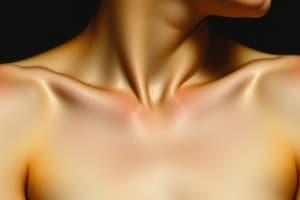Podcast
Questions and Answers
What is the primary affected area in lichen sclerosus et atrophicus?
What is the primary affected area in lichen sclerosus et atrophicus?
- Back and shoulders
- Anogenital area (correct)
- Lower limbs
- Face and neck
Which of the following is a possible pathogenesis for lichen sclerosus et atrophicus?
Which of the following is a possible pathogenesis for lichen sclerosus et atrophicus?
- Bacterial infection
- Excessive sun exposure
- High estrogen state
- Autoimmunity (correct)
Which of the following is a characteristic feature of lichen sclerosus et atrophicus?
Which of the following is a characteristic feature of lichen sclerosus et atrophicus?
- Blistering and oozing lesions
- Raised, itchy papules
- Red, scaly patches
- Smooth, white parchment-like areas (correct)
What are the reported correlations in terms of genetic susceptibility for lichen sclerosus et atrophicus?
What are the reported correlations in terms of genetic susceptibility for lichen sclerosus et atrophicus?
Which group of women primarily have lichen sclerosus et atrophicus?
Which group of women primarily have lichen sclerosus et atrophicus?
Which condition is characterized by vulval and perianal itching, pain from skin trauma, and dysuria?
Which condition is characterized by vulval and perianal itching, pain from skin trauma, and dysuria?
Which of the following is not a known infectious cause of lichen sclerosus et atrophicus?
Which of the following is not a known infectious cause of lichen sclerosus et atrophicus?
Which condition is a non-specific response to recurrent scratching to relieve pruritus, characterized by white plaques and marked epidermal thickening?
Which condition is a non-specific response to recurrent scratching to relieve pruritus, characterized by white plaques and marked epidermal thickening?
Which condition is characterized by verrucous lesions on the vulva, perineum, and vagina, caused by sexually transmitted HPV types 6 or 11?
Which condition is characterized by verrucous lesions on the vulva, perineum, and vagina, caused by sexually transmitted HPV types 6 or 11?
Which condition is associated with dysplasia, varying degrees of atypia, and has not invaded the basement membrane but has invasive potential?
Which condition is associated with dysplasia, varying degrees of atypia, and has not invaded the basement membrane but has invasive potential?
What is the main issue in lichen sclerosus?
What is the main issue in lichen sclerosus?
What is the characteristic histological feature of lichen simplex chronicus?
What is the characteristic histological feature of lichen simplex chronicus?
What is the cause of condyloma acuminatum?
What is the cause of condyloma acuminatum?
What is a common symptom of lichen sclerosus?
What is a common symptom of lichen sclerosus?
What type of women are most commonly affected by classic (VIN)?
What type of women are most commonly affected by classic (VIN)?
What is a distinguishing feature of vulval intraepithelial neoplasia in postmenopausal women?
What is a distinguishing feature of vulval intraepithelial neoplasia in postmenopausal women?
What is the uncertain pathogenesis of lichen sclerosus et atrophicus thought to involve?
What is the uncertain pathogenesis of lichen sclerosus et atrophicus thought to involve?
What is the characteristic feature of squamous vulvar intraepithelial neoplasia (VIN)?
What is the characteristic feature of squamous vulvar intraepithelial neoplasia (VIN)?
Which condition is a non-specific response to recurrent scratching to relieve pruritus, characterized by white plaques and marked epidermal thickening?
Which condition is a non-specific response to recurrent scratching to relieve pruritus, characterized by white plaques and marked epidermal thickening?
What is the primary affected area in lichen sclerosus et atrophicus?
What is the primary affected area in lichen sclerosus et atrophicus?
What is the distinguishing feature of vulval intraepithelial neoplasia in postmenopausal women?
What is the distinguishing feature of vulval intraepithelial neoplasia in postmenopausal women?
What is the main issue in lichen sclerosus et atrophicus?
What is the main issue in lichen sclerosus et atrophicus?
What is the distinguishing feature of vulval intraepithelial neoplasia in postmenopausal women?
What is the distinguishing feature of vulval intraepithelial neoplasia in postmenopausal women?
Which condition is associated with dysplasia, varying degrees of atypia, and has not invaded the basement membrane but has invasive potential?
Which condition is associated with dysplasia, varying degrees of atypia, and has not invaded the basement membrane but has invasive potential?
What is the characteristic histological feature of lichen simplex chronicus?
What is the characteristic histological feature of lichen simplex chronicus?
Which condition is characterized by vulval and perianal itching, pain from skin trauma, and dysuria?
Which condition is characterized by vulval and perianal itching, pain from skin trauma, and dysuria?
What is the cause of condyloma acuminatum?
What is the cause of condyloma acuminatum?
What type of women are most commonly affected by classic (VIN)?
What type of women are most commonly affected by classic (VIN)?
What are the reported correlations in terms of genetic susceptibility for lichen sclerosus et atrophicus?
What are the reported correlations in terms of genetic susceptibility for lichen sclerosus et atrophicus?
[Difficult] What is the uncertain pathogenesis of lichen sclerosus et atrophicus thought to involve?
[Difficult] What is the uncertain pathogenesis of lichen sclerosus et atrophicus thought to involve?
[Difficult] What is the main issue in lichen sclerosus et atrophicus?
[Difficult] What is the main issue in lichen sclerosus et atrophicus?
Flashcards are hidden until you start studying




